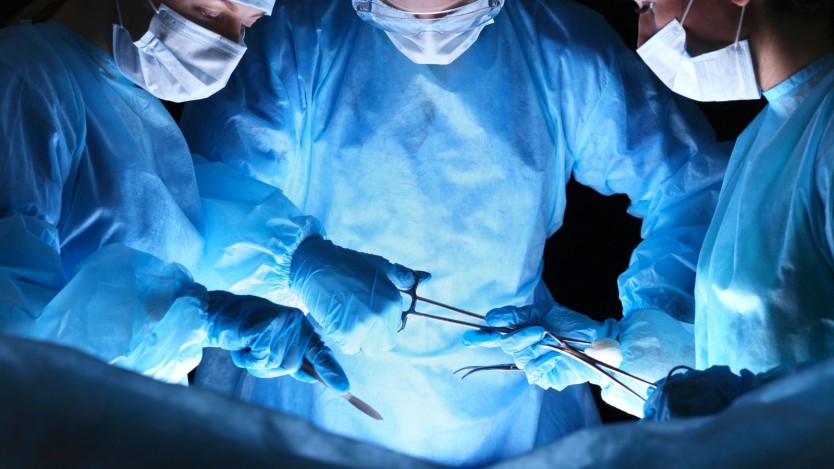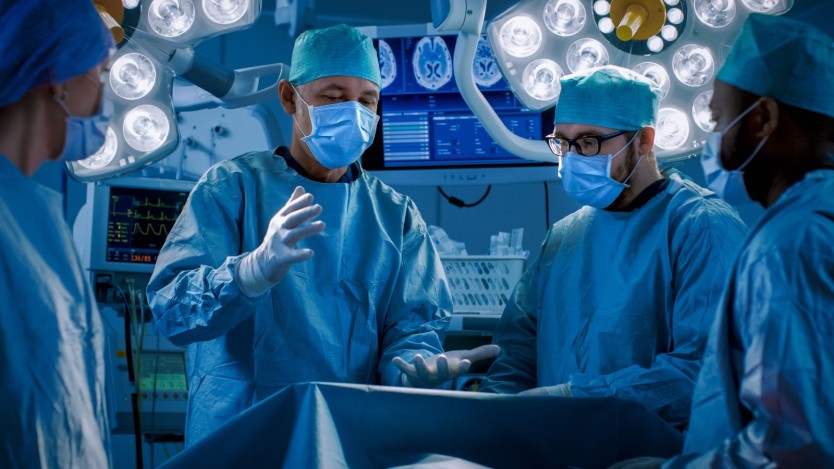Adenoids removal surgery: duration, cost and step by step

- What are adenoids?
- Why is adenoids removal surgery necessary?
- When is adenoids surgery performed?
- Preoperative for adenoids surgery
- Adenoids surgery: step by step
- Duration of adenoids surgery
- Cost of adenoids surgery
- Request a surgical assessment consultation with a specialist through Operarme
- Adenoids are glands that are part of our immune system. They generate antibodies to protect us from infections.
- During childhood, adenoids become hypertrophied, causing breathing problems. Initial treatment is usually with medication, but this is not always a definitive solution. In these cases, adenoids surgery is the optimal solution.
- Adenoids removal surgery consists of removing the adenoids and thus eliminating the problems caused by their enlargement, such as frequent ear and throat infections.
What are adenoids?
The adenoids are two glands that form part of our immune system along with the tonsils and lymph nodes. The adenoids are located one on each side of the nasopharynx or cavum, above the soft palate and behind the nose.
These glands, unlike the tonsils, cannot be seen when opening the mouth because they are above the soft palate.
This formation generates antibodies and lymphocytes in order to fight possible infections and thus help the immune system to prevent various diseases caused by bacteria and viruses present in the air we breathe through our mouth or nose.
The adenoids are formed from the seventh month of life, continue to develop until the age of four and reduce in size at puberty.
However, it can happen that the adenoids grow too large and even obstruct the passage of air through the nasal passage, resulting in permanent adenoid hypertrophy.

Do you need surgery to remove adenoids?
Request a free and immediate appointment with our specialists in Otorhinolaryngology
The adenoid tissue is very susceptible to infection and inflammation as it is attached to various ducts such as the nasal, larynx and Eustachian tubes, the ventilation ducts of the ears.
This can cause problems such as obstruction of the airways, the appearance of abundant mucus in the throat or the blockage of ventilation in the ears. This often leads to snoring, bronchitis, sleep apnoea and otitis.

Initially, the indicated treatment is by taking drugs to reduce the inflammation and eliminate the infection.
When this treatment does not work, specialists recommend surgical treatment as a definitive solution, i.e. adenoids removal surgery, also known as adenoidectomy, which removes the glands and eliminates the symptoms caused by the abnormal development of the glands.
Adenoids surgery is performed on an outpatient basis, so you can leave the hospital on the same day as the operation. Adenoidectomy is not a complicated procedure and it does not alter the immune system, so you will no longer be exposed to germs or consequent illnesses.
Why is adenoids removal surgery necessary?
The increase in the size of the adenoids affects the production of lymphocytes and antibodies, so that our organism would be unprotected from germs and bacteria that may invade the nasal and oral cavities.
When the adenoids become larger, they obstruct the passage of air, giving rise to adenoid hypertrophy.
In these cases, specialists resort to surgical treatment to eliminate the various problems affecting the respiratory and auditory system, especially in children.
Sometimes adenoids can be solved by medical treatment with antibiotics or nasal sprays. However, when the drugs do not work, adverse effects may develop that aggravate the condition. In these cases, specialists in the field recommend adenoids surgery.
It is an operation that can be performed on both children and adults, always with a prior diagnosis and under the assessment of an expert in Otorhinolaryngology.
The cases in which adenoids surgery is indicated are as follows:
- Large adenoids. In these cases, the glands block the airways causing symptoms such as snoring, trouble breathing through the nose and episodes of breathing failure during sleep.
- Chronic ear infections. The frequency of these infections occurs when they do not respond to drug treatment. Hypoacusis, i.e. reduced hearing ability is a consequence of enlarged adenoids, as well as ailments in children that do not allow them to continue their lives normally.
In addition, it is very common to opt for adenoidectomy when suffering from tonsillitis, inflammation and infection of the tonsils, on a recurrent basis.
When is adenoids surgery performed?
As you may already know, the adenoids are glands located in the upper part of the pharynx, more specifically in the cavum, forming part of our immune system along with the tonsils and lymph nodes.
This formation generates antibodies and lymphocytes to protect us from infections and various diseases caused by bacteria and viruses present in the air.
When there is hypertrophy in the adenoids, our immune system is unprotected from external agents and some common symptoms of abnormal growth of the adenoids become evident, such as nasal obstruction, chronic otitis media, sinusitis, bronchitis, persistent rhinitis, tonsillitis and pharyngitis. In these cases, to avoid complications and health risks, adenoids surgery or adenoidectomy is recommended.

That said, it is clear that there are a number of reasons why specialists resort to adenoid surgery, although all are aimed at relieving discomfort and eliminating breathing problems, especially in the case of children.
In any case, whether it is you or your child who is going to undergo adenoidectomy, it is necessary to speak to a specialist in Otolaryngology to find out the reasons why this procedure is usually performed. In the same way, it is essential to diagnose the causes of adenoid hypertrophy, the possibilities of its removal and to know how this can favour your quality of life and general health.
There are numerous consequences of adenoid hypertrophy for which a patient would seek adenoid surgery. Among them, we highlight:
- Chronic adenoiditis. When drugs are not effective and the pathology persists over time, the only effective solution is adenoid surgery. This involves removing the adenoids and, normally, the tonsils are removed during the same operation.
- Sleep apnoea and respiratory obstruction. Inflammation of the adenoids and tonsils leads to an increase in nocturnal breathing problems, as well as general sleep problems, so a specialist would recommend adenoid surgery.
- Tumour in the throat or nostrils. This problem, usually associated with older adults, is necessarily solved with adenoids surgery.
- Frequent infections. Normally occurring in children, until they have completed their developmental stage, they can occur up to 7 or more times a year. As a result of these infections, the child may be absent from school or, in the case of adults, from work. Adenoids surgery is used as a remedy.
- Chronic otitis. When pharmacological treatment is ineffective and inflammation of the adenoids is prolonged over time, ventilation of the auditory pathways is obstructed, causing otitis, suppuration and hearing loss. Therefore, the best option in these cases is adenoid surgery.
Preoperative for adenoids surgery
For adenoid surgery, as for any surgical intervention, a preoperative study of the patient is necessary. As you already know, Operarme includes among its services a series of services for the patient.
At this point, it is worth highlighting the free surgical assessment consultation, in which it is advisable to hand over all the tests you have undergone previously.
A personal advisor from the Operarme's patient service team will have indicated and explained to you what you should bring and hand in at the admissions desk. In this way, the preoperative tests that will favour the success of the surgical assessment are as follows:
- Electrocardiogram. With this test, the doctor and anaesthesiologist check your cardiovascular health to determine whether or not you are suitable for adenoid surgery.
- Blood test. The results of the blood test are used to determine whether there is a possible infection in your body. If positive, the infection must be treated and controlled before surgery.
- Chest x-ray. This test is only performed if the doctor considers it necessary to rule out signs of infection and to check that your trachea is perfectly aligned, in case intubation is requested.
After the preoperative period, you will be informed of the need to have a consultation with the anaesthesiologist to determine whether you are suitable for tonsil surgery, at the same time as the adenoids surgery is performed.
As you know, during this surgery, the tonsils are removed, so the consultation with the anaesthesiologist will be decisive in making this decision.
Consultation with the anaesthesiologist for adenoids surgery
In the consultation with the anaesthesiologist, the preoperative study you have submitted will be reviewed. In addition, you will be asked several questions about your lifestyle, previous operations, medications etc.
All of this will determine whether you are fit for surgery and indicate the type of anaesthesia that is suitable for you.
Adenoidectomy is performed under general anaesthesia. This can be administered by means of drugs or with a mask that distributes the medication through the airways until the whole body is anaesthetised.
It should be added that throughout the surgical procedure, the anaesthetist will monitor your vital signs, pulse, blood pressure, oxygenation and anaesthetic levels.

Do you need surgery to remove adenoids?
Request a free and immediate appointment with our specialists in Otorhinolaryngology
Adenoids surgery: step by step
On the day of the surgical intervention, you will have to go to the admissions office and hand in all the documentation mentioned in the previous point. You don't have to worry about anything, as a member of our patient counselling team will have contacted you to tell you everything you need to know about this day.
Once you have done this, you will go to the operating theatre area where you will be given surgical clothes so that you can dress appropriately for the operation. You will then be given an IV to keep you hydrated and to administer the anaesthetic.

Once you are ready, you will be taken to the operating theatre where the adenoidectomy will take place.
There, you will meet the surgeon and the anaesthesiologist, with whom you had your consultations, and a member of the nursing team.
Once you are on the table, the adenoidectomy surgery will begin. We summarise it for you in 4 simple steps:
- The first thing to do is to administer the anaesthetic through the line that has been previously placed in your arm or, alternatively, you will be fitted with a mask through which you will inhale the medicine.
- Once the anaesthetic has taken effect, the surgeon will place a small tool in your mouth to keep it open during the surgery.
- The surgeon will then remove the adenoid glands using a curette, a cuckoo-shaped instrument to remove the tissue. In addition, other tools may be used to cut the tissue. Some surgeons use electrocautery to heat the tissue, remove it and stop the bleeding. Another method is coblation, which, like the previous technique, uses radiofrequency energy.
- Lastly, you will be given absorbent compresses to stop any bleeding and to check that the extraction has been carried out correctly.
As you may already know, adenoids surgery is common in children and adults. Once the operation is over, you or your child will stay in the recovery room until you wake up.
When you can breathe, cough and swallow without difficulty, you will be discharged and can leave the hospital. This will usually be several hours after the operation.
Duration of adenoids surgery
Adenoids surgery is a fast, simple surgical procedure with a relatively short recovery time. The average time for each stage, both intraoperative and postoperative, is fast.
Adenoids surgery lasts approximately 15-20 minutes, which can be extended to 40 minutes if the tonsils are also removed. As we mentioned above, adenoidectomy can be complemented with tonsillectomy, unless otherwise indicated in the preoperative stage. In any case, once the surgery is over and you have recovered from the effects of the anaesthesia, you will be able to go home.
During the recovery stage, you must follow the instructions of the ENT specialist for the next two weeks after the operation. However, the improvement will be noticeable after the first 24 hours following surgery.
Cost of adenoids surgery
The price offered by Operarme for adenoids surgery includes everything necessary to perform the intervention as safely and effectively as possible, for you or your child.
This is a fixed, all-inclusive cost for the removal of the adenoid glands for 1.890 €.
What is included in the price of Adenoids surgery?
Hiring adenoids surgery through Operarme to carry out adenoid removal involves a series of services included in the final price, all of which are necessary to ensure the patient's peace of mind, safety and comfort.
Below, you will find a breakdown of all the elements:
- Booking and use of the operating theatre.
- Post-operative care until medical discharge.
- Medical fees.
- Anaesthesiologist fees.
- Nursing team fees.
- Surgical material necessary for the operation.
However, if you would like to know more about the adenoids removal operation or what the service includes with Operarme, it is best to contact our patient service team via the contact form.
Request a surgical assessment consultation with a specialist through Operarme
If you or your child has problems with chronic adenoid inflammation and infection and you are considering adenoids surgery as the most appropriate solution, you can request a free surgical assessment consultation with our team of specialists in Otorhinolaryngology.
In this way, you will be able to decide, under the criteria of an expert in the field, which is the best option to eliminate the problems caused by adenoids.
If you would like to make an appointment for the specialist to familiarise himself with your or your child's case, you can contact us by calling at +34 91 141 33 56, or by filling in our contact form, by clicking on the following banner:

Do you need surgery to remove adenoids?
Request a free and immediate appointment with our specialists in Otorhinolaryngology
Medical disclaimer: All the published content in Operarme is intended to disseminate reliable medical information to the general public, and is reviewed by healthcare professionals. In any case should this information be used to perform a diagnosis, indicate a treatment, or replace the medical assessment of a professional in a face to face consultation. Find more information in the links below:


